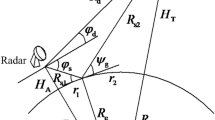Abstract
The multipath signal and direct signal lying within a beamwidth of a receiving antenna are highly correlated, which degrades the performance of DOA in a VHF array radar. Especially on rough terrain, the reflection centers of elements are not at the same horizontal plane; thus the variation of indirect wave path difference from each element with respect to the target’s depression angle is not linear. In this paper, we assume the two-path-component data model, with one direct component and one indirect component related to the ground reflection. This paper builds a highly deterministic multipath signal model which takes the curvature of the signal path and the terrain parameters of the reflection region into account based on the sphere model, gives calculation methods of the reflection coefficient and lengths of the direct path and indirect path, and proposes a synthetic steering vector super-resolution algorithm. The results for both simulated and measured data show that this method provides excellent performance in resolving the DOA problem in a multipath environment compared to the data model that only considers the flat-earth model.









Similar content being viewed by others
References
L.V. Blake, Radar Range-Performance Analysis (Artech House, New York, 1986)
F. Gao, A.B. Gershman, A generalized ESPRIT approach to direction of arrival estimation. IEEE Signal Process. Lett. 12(3), 254–257 (2005)
M. Haardt, J.A. Nossek, Unitary ESPRIT: how to obtain increased estimation accuracy with a reduced computational burden. IEEE Trans. Signal Process. 43(5), 1232–1242 (1995)
X.Q. Hu, J.W. Chen, Y.L. Wang, Research on meter-wave radar height-finding multipath model. Chin. J. Radio Sci. 23(4), 651–657 (2008) (in Chinese)
J. Li, Improved angular resolution for spatial smoothing techniques. IEEE Trans. Signal Process. 40(12), 3078–3081 (1992)
T. Lo, J. Litva, Use of a highly deterministic multipath signal model in low-angle tracking. IEE Proc. F 138(2), 163–171 (1991)
T. Lo, J. Litva, Low-angle tracking using a multifrequency sampled aperture radar. IEEE Trans. Aerosp. Electron. Syst. 27(5), 797–805 (1991)
S.U. Pillai, B.H. Kwon, Forward/backward spatial smoothing techniques for coherent signal identification. IEEE Trans. Acoust. Speech Signal Process. 37(1), 8–15 (1989)
S.M.I. Radar, Handbook, 2nd edn. (Publish House of Electronics Industry, Beijing, 2003)
R.O. Schmidt, Multiple emitter location and signal parameter estimation. IEEE Trans. Antennas Propag. 24(3), 276–280 (1986)
J. Selva, Computation of spectral and root MUSIC through real polynomial rooting. IEEE Trans. Signal Process. 53(5), 1923–1927 (2005)
P. Stoica, B. Ottersten, M. Viberg et al., Maximum likelihood array processing for stochastic coherent sources. IEEE Trans. Signal Process. 44(1), 96–105 (1996)
P. Surendra, C. Bindu, Direction-of-arrival estimation using rank revealing QR factorization. IEEE Trans. Signal Process. 39(5), 1224–1229 (1991)
X.Y. Yang, Study on Array Super-resolution and Altitude Measurement in VHF Radar (Xidian University, Xi’an, 2011) (in Chinese)
G.H. Zhao, B.X. Chen, M. Dong, A new DOA estimator based on alternating projection and its application in VHF radar. J. Electron. Inf. Technol. 30(1), 224–227 (2008) (in Chinese)
Acknowledgements
This work is supported by the National Natural Science Foundation of China (61001209, 61101244), the Fundamental Research Funds for the Central Universities (JY10000902010), and the Aeronautical Science Fund (20100181010).
Author information
Authors and Affiliations
Corresponding author
Rights and permissions
About this article
Cite this article
Zhu, W., Chen, BX. Altitude Measurement Based on Terrain Matching in VHF Array Radar. Circuits Syst Signal Process 32, 647–662 (2013). https://doi.org/10.1007/s00034-012-9472-4
Received:
Revised:
Published:
Issue Date:
DOI: https://doi.org/10.1007/s00034-012-9472-4





